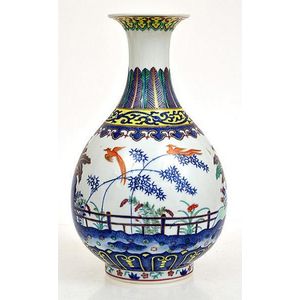Blue and white Qianlong-style vase with nature scene
You must be a subscriber, and be logged in to view price and dealer details.
Subscribe Now to view actual auction price for this item
When you subscribe, you have the option of setting the currency in which to display prices to $Au, $US, $NZ or Stg.
- Arabesque - The arabesque pattern is an ornamental design that features flowing, curving lines and elaborate geometric shapes. It is inspired by the art and architecture of the Islamic world and was developed at Fontainebleu France in the mid 16th century. Its use was spread through published engravings, and it is characterized by its intricate and highly decorative nature. The arabesque pattern is created using a repetitive motif that is repeated and interwoven to create a cohesive design. It was used as a form of decoration in art, architecture, textiles, pottery, furniture and ceramics and it is often used to add a sense of grandeur and sophistication to a design. The arabesque pattern is admired for its beauty and complexity, and it continues to be used in a wide range of decorative contexts today.
- Fleur-De-Lis - The fleur-de-lis is a stylized lily or iris flower with
three petals that has been used as a decorative motif for thousands of years. It
often appears in Christian iconography symbolising the Holy Trinity and as an
emblem that reflects the purity of the Virgin Mary. In decorative art and antiques
decoration, the fleur-de-lis is often used as a symbol of elegance, refinement,
and good taste.
The fleur-de-lis has a rich history and in ancient times, it
was associated with royalty, purity, and the divine, and it was used as a
symbol of the French monarchy for many centuries.
It is a common design element in ceramics, silverware, jewellery,
furniture, and other decorative objects, and it can be found in many different
styles and forms. - Lappet Decoration - In the context of furniture, ceramics, and oriental wares, the word "lappet" refers to a decorative motif that consists of a repeated pattern of stylized or abstracted "lappets."
A lappet in this context is a decorative element that resembles a small, hanging flap of cloth or fabric, but rather are stylized patterns that resemble the shapes and folds of lappets. They can be found on a wide range of objects, including furniture, vases, bowls, and plates.
Lappet decoration can take many different forms, but typically consists of a series of semi-circular or pointed shapes that are repeated in a continuous pattern. The shapes may be simple or highly ornate and may be arranged in a regular or irregular pattern. The design may also include other decorative elements, such as floral or foliate motifs.
Lappet decoration is often associated with Asian design traditions, and can be found on a wide range of objects from these regions, including Chinese porcelain, where lappet decoration is often used as a symbol of abundance and prosperity, and is believed to have protective and auspicious qualities.
This item has been included into following indexes:
Visually similar items

Chinese porcelain Doucai bottle vase with phoenix scene, seal mark to base, 31 cm high

A Chinese bottle vase in the Qing manner. Republic era. Of typical ovoid form with a slender neck with a trumpet style rim decorated in a predominantly green and iron red palette with birds in a rocky landscape and flowering branches; with four character J

Moorcroft Duet vase. Designed by Nicola Stanley, signed by Phillip Gibson, 2004. Height 21 cm

A Chinese vase. Under glaze Qianlong mark. Globular form with flared neck painted with birds and peony, the cylindrical neck with lotus decoration. 43 cm high.
